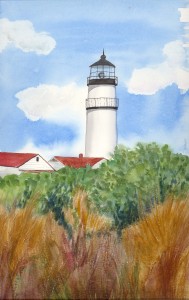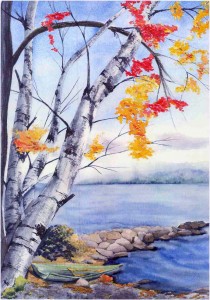Do you have questions to ask an artist?
If you can find the answer here, please email me at jane@janemayjones.com.
What are the note cards like?
Note cards sold by Corner House Creations are all reproduced from original watercolors painted by me, Jane May Jones. They are sold and packaged as follows:
My cards are made of watercolor paper and have a deckled edge with matching envelopes and are 5″ by 7″. They are sold in packages of 6.
Long note cards are 3.75″ by 7.5″ and are sold in packages or one and six.
What is the difference between Signed & Numbered Limited Edition and Artist Proof?
 Signed / Numbered Limited Edition Print (S/N): means that a set number of prints have been reproduced from one origninal. I sign and number the prints, in a visible location. For example you might own 10/100 which means that you own the 42nd copy of that reproduction.
Signed / Numbered Limited Edition Print (S/N): means that a set number of prints have been reproduced from one origninal. I sign and number the prints, in a visible location. For example you might own 10/100 which means that you own the 42nd copy of that reproduction.
Artist Proof: Artist proofs are a tradition in printmaking and are generally limited to a a very small number of prints. These prints are the first ones off the press and are made especially for the Artisit to check the edition for color and clarity. They are considered to be more valuable and more of a collector item because there are fewer available. Quality between the regular edition and the AP is equal. The differences are the “AP” designation and that they have a lower-number edition.
What is an Open Edition?
This is not limited to a specific edition size and may be reproduced more than once. It may also be hand signed by me and would be designated as such.
What is an Edition Size?
All prints are done in specified edition sizes. Determined by the publisher and/or artist.
What is a Giclee or Iris print?
A Giclee (pronounced Gee Clay) print is a piece of artwork reproduced on canvas or paper by using a high quality digital  ink printer. Iris printing is a specific form of Giclee printing. Giclee is a term to describe fine art inkjet printing. There are many types of printers used to create Giclee prints. The Iris printer is considered the highest quality printer for this form of printing. Giclee is a French term, loosely translated to “to spray”. In this way it is an appropriate description of the Iris printing method. The term was created to differentiate a commercial standard from the work of a fine art print. The fine art prints made on an Iris printer are made with higher quality inks and are printed on fine watercolor papers or canvas.
ink printer. Iris printing is a specific form of Giclee printing. Giclee is a term to describe fine art inkjet printing. There are many types of printers used to create Giclee prints. The Iris printer is considered the highest quality printer for this form of printing. Giclee is a French term, loosely translated to “to spray”. In this way it is an appropriate description of the Iris printing method. The term was created to differentiate a commercial standard from the work of a fine art print. The fine art prints made on an Iris printer are made with higher quality inks and are printed on fine watercolor papers or canvas.
The method for coaxing a fine art print from the Iris printer is a delicate work far removed from the Iris’s original purpose of printing color proofs for offset lithographers. The Iris is a large drum based inkjet printer made up of a complex array of mechanics. The Iris squirts a million red blood cell sized droplets of ink from each of its four nozzles (Cyan, Magenta, Yellow and Black) every second at a speed of 85 miles per hour towards a drum rotating at a speed of 150 inches per second. These droplets are given an electric charge on their way to the drum either positive or neutral, this allows the printer to determine which should actually hit the drum and which should be deflected away to the waste system. This process produces a continuous tone image on the paper with an apparent resolution of 1800 dots per inch.
The procedure to get to this point in fine art printing starts with the artist selecting an image for the printer to produce. This image is captured on film and sent to the printer for scanning. The scanned image is brought into the computer for sizing, cropping and color balancing. The most important step is then taken of converting the image from the computers RGB color space to that of the printers CMYK color space. A proof is made and sent back to the artist for critique, and corrections are applied as needed until the artist approves the proof image. It is this stage, where the artist and printer collaborate to bring the print to life, that differentiates a fine print from a commercial one. At this point the image is then ready for its final printing. Reprinted courtesy of EJ Arts www.ejarts.com
What is Dry Mounting?
For lifelong protection and 100% “flat forever” appearance ask your framer about dry mounting, a pressurized seal that adheres your print to an acid-free foamcore board permanently. This process alleviates any wrinkling or warping with humidity or weather changes. This is not a laminate or anything that will cover the surface of your print. It is relatively inexpensive and well worth the extra cost. Usually not done on limited edition print, but something to enhance longevity of an open edition print or poster.
What about Acid-Free Matting?
Also ask your framer about acid-free matting to ensure that your print won’t fade, yellow, or discolor, once it is framed.
